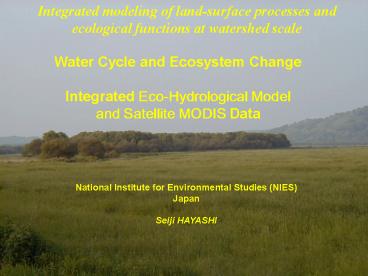Water Cycle and Ecosystem Change PowerPoint PPT Presentation
1 / 32
Title: Water Cycle and Ecosystem Change
1
Integrated modeling of land-surface processes and
ecological functions at watershed scale
Water Cycle and Ecosystem Change Integrated
Eco-Hydrological Model and Satellite MODIS Data
National Institute for Environmental Studies
(NIES) Japan Seiji HAYASHI
2
Background
Hokkaido
Drying Phenomena of Wetland by Sediment Inflow
Kushiro Mire Area176.74km2 (largest in
Japan) 1980Designation of Ramsar
Convention on Wetlands 1987Designation of
National Park
Kushiro River Watershed
Agricultural Development and River Channelization
? Increase in Inflow Volume of Sediment at
Runoff ? Sediment Accumulation in
Wetland ? Propagation of Alnus japonica ? Drying
of Wetland
3
Distribution of turbid water in Kushiro Marsh
High
Low
Water Turbidity Index (WTI) calculated from TM
Landsat image, May 17 1994
4
Change of vegetation phenology in the Kushiro
Mire
Background
- Drying phenomena in the Mire ? Change of
phenology - ?
- Propagation of Alnus japonica, intrusion of
willow trees - ?
- Change of ecosystem function in the Mire
Temporal change in the distribution of Alnus
japonica.
5
Reclamation of the Kushiro Mire
Background
Requirement of reclamation plan based on the
comprehensive understanding of water cycle in the
whole watershed direct inflow, groundwater
supply, phenological effect of vegetation, etc.
In order to obtain the understanding and develop
the reclamation plan, Approach using a
physically based model with the comprehensive
observed data is absolutely necessary
6
Objective
Integrated physical-based distributed model for
water cycle and heat budgets into which the
effect of vegetation phenology incorporates. Pre
dicting drying phenomena of the Mire, such as
decrease in surface soil moisture and degradation
of G.W.L., etc. Assimilation of MODIS
(Moderate Resolution Imaging Spectroradiometer)
satellite data into eco-hydrological model for
seasonal variation of vegetation phenology in
global watershed
7
Observation
Meteorological Station at 3 Points (Forest,
Grassland, Mire) Ground-Water Flow Level at 30
Points River Flow Level at 13 Points
Kushiro River Watershed Area2204.7km2
1km scale
500m scale
Integrated Eco-Hydrological Model
Use of MODIS Satellite Data
GIS Database Meteorological Data Geological
Database Vegetation Phenology
FPAR, LAI, NDVI changes by vegetation phenology
Schematic of this study in the Kushiro River
watershed
8
Ground Observation
9
Ground Observation
10
Ground Observation
Meteorological observation system in Kushiro
mire. N4306'05?E14420'29??mean elevation8m)
11
Ground Observation
T-1
I-1
O-1
K-2
Ku-1
H-1
Tsu-1
Ku-2
Results of soil property and field permeability
test.
12
MODIS Data Utilization
Tomakomai flux-tower of CGER/NIES
(N4244'13.1??E14131'7.1??mean
elevation115140m) Forest vegetation of
needle-leaf tree
13
MODIS Data Utilization
(a) Land surface temperature of MODIS-LST value.
(b) FPAR value.
Comparison of MODIS data of 3x3 grid average with
the synchronized Tomakomai ground-truth observed
value.
14
MODIS Data Utilization
15
MODIS Data Utilization
16
MODIS Data Utilization
Temporal variations of MODIS products at three
meteorological stations in the Kushiro Watershed
from January 1 to December 31 in 2001.
17
Model Development
Structure of Integrated Hydrological Model
Satellite Remote-sensing Monitoring System (MODIS)
- Model Inputs
- Remote-sensing Data
- GIS Database
- Climatic, Vegetation, Soil
- Observational Data
Precipitation
Evaporation Transpiration
Fluxes Tower and Ecosystem Observation Network
Land-surface Models (SiB2)
Surface
Runoff
Grid-based Hydrological Model Hill Slope Model
Kinematic Wave Model Stream Network Model
Dynamic Wave Model
Infiltration
Combination
Intermediate Flow
Richards Formula (Soil Moisture)
Unsaturated Soil Layer
Surface Upflow
Combination
Infiltration
- Model Outputs
- Water/Heat fluxes
- Evapotranspiration
- Soil Moisture
- Runoff
- Discharge
- Groundwater level
Ground-water Flow
3D Groundwater Flow Model (MODFLOW)
Ground water Layer
Deeper Ground-water Recharge
Geological Database
18
Model Development
Land-Surface Model
Measurements of Ecological Station
Biome model
Provide Data for Calibration and Validation of
models
Richards Formula
MODFLOW Model
19
Model Development
Concept of Water Cycle Simulator
Description of watershed model.
20
Bed slope land cover in Kushiro River.
Model Development
Forest
Grassland, Farm
Mire
1/1,500 Gojyukkoku
1/7,500 Iwabokki
1/300 Teshikaga
Downstream
Upstream
21
Model Development
Obs. Flow depth meter(NIES)
Obs. Flow depth meter(Hokkaido Development Bureau)
Stream network of grid-based hydrological model
in Kushiro River watershed.
22
Model Development
(a) Vertical grid discretization
(b) Vertical geological structure
Cross-section view of vertical grid
discretization and geological structure, 12.5 km
from the west edge of calculation area.
23
Model Validation
Obs.
NR ? Net radiation LH ? Latent heat flux SH ?
Sensible heat flux GH ? Ground transfer
heat flux
Cal.
Heat flux budget in grassland. (2001/8/18/5)
24
Model Validation
(a)Mire
(b)Grassland
(c)Forest
Time-series of precipitation and soil moisture at
three meteorological stations from August 1 to
October 31 in 2001.
25
Model Validation
I-1
O-1
W-5
Ku-2
C-1
Temporal variation of ground-water levels from
May 1 to November 31 in 2001.
26
Model Validation
Temporal variation of river discharge from May 1
to October 31 in 2001. Sub-river into Kushiro
mire (Kucyoro).
27
Final Result
Alnus japonica distribution
WTI
G.W.L.(Cal.)
Autumn (SeptemberNovember)
Winter (DecemberFebruary)
Spring (MarchMay)
Summer (JuneAugust)
Relation between G.W.L., Alnus japonica
distribution and WTI.
28
Drying Phenomena of Wetland by Sediment Inflow
Kushiro Mire Area176.74km2 (largest in
Japan) 1980Designation of Ramsar
Convention on Wetlands 1987Designation of
National Park
Agricultural Development and River Channelization
? Increase in Inflow Volume of Sediment at
Runoff ? Sediment Accumulation in
Wetland ? Propagation of Alnus japonica ? Drying
of Wetland
29
Perspective
Utilization of MODIS data products for the
improvement of the hydrologic model
performance in the Changjiang River Basin
Application of Integrated Eco-Hydrological Model
to China for the prediction of effect of land
use change, western development, and
large-scale water-conveyance from the Chang-Jiang
to Huang-He on water resources
30
Comparison of observed stream flowrate with the
simulation results of hydrologic model at the
hydrologic stations on the Changjiang mainstream
At Yichang
At Datong
31
Beijing
Huang He
ErosionSandfication
Western development
Drought
East China Sea
Water-conveyance
Increase in food production
Water-conveyance
Salinization
Increase in pollutant load
Flood
Chang Jiang
Deforestation
Three Gorges Dam
32
(No Transcript)

